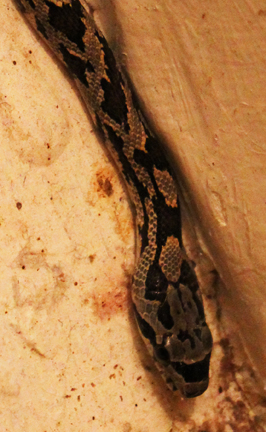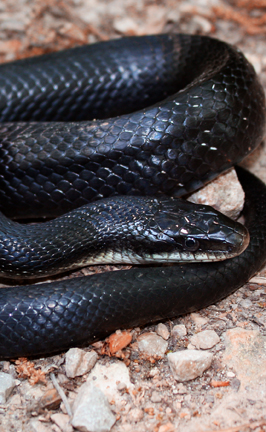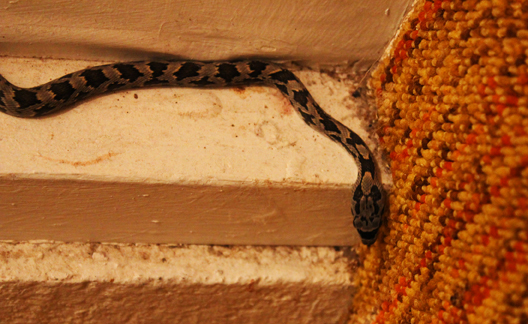Black Rat Snake
by Ben Dalton
One of my mother’s earliest childhood memories — and one of her most vivid — is of an encounter with a black rat snake (“black snake” to her). This particular summer she had convinced her parents to let her have a clutch of chicks to raise by hand. Since the chicks were so small and vulnerable, my mother was raising them in the basement of their old house. One day, she heard a terrible commotion from the basement. Rushing down she froze as she spotted the cause of the commotion: “the biggest snake she had ever seen” was enjoying a quick snack of a chicken tender... or twelve. Mom abruptly fled the scene calling for parents to deal with the problem. By the time they arrived, the snake had left by the same mysterious way it came in.
I’m sure almost everybody growing up on an Ozark farm has come across a black rat snake at some point in their lives. Not all stories are as graphic as my mother’s, but these snakes’ feeding habits often bring with them an undeserved reputation of meanness.
The black rat snake (Pantherophis obsoletus) is common across the greater portion of the Midwest and eastern United States. Fairly recently, taxonomists split the species due to genetic and geographic variation. West of the Mississippi River, it is the Western (or Texas) rat snake that is found.
The Latin name Pantherophis comes from panther, meaning “predator of all” and ophio, meaning “snake.” Although it is not clear why a rat snake might be considered the “predator of all snakes,” what is clear is the wide variety of prey the snakes consume.
The species name obsoletus means “to wear out” or “fall into disuse,” possibly referring to the snakes’ change in coloration from juvenile to adult.
The black rat snake doesn’t start out with its black back. When they hatch, young black rat snakes have a beautiful brown-on-gray patterning that resembles some other rat snake species, including the Plains rat snake (Pantherophis emoryi). As they grow, they never lose their blotchy pattern but rather the black coloration starts to appear over top of it. Eventually, the black pigmentation becomes so prominent the juvenile pattern is all but invisible to the casual observer. If you look closely at some adults, however, you can still see hints of where the patterning used to be.
Another interesting aspect of the black rat snake’s coloration is the ventral (belly) surface. Many snakes have a uniformly colored belly but the underside of a black rat snake is almost checkered black-and-white. Just like the black pigmentation on their backs, the older the snake, the more prominent the coloration.
Black rat snakes are most at home in forests but can be found anywhere their food sources are abundant. As their name implies, rat snakes eat mice and rats (as well as almost anything that will fit in their mouths).
Their diet extends to other rodents, lizards, frogs, and yes, birds and bird eggs. Black rat snakes are excellent climbers known for climbing near-vertical surfaces so raiding bird boxes or chicken coops are a piece of cake.
Rat snakes are not venomous. They kill their prey by constriction: holding on with many small, sharp teeth and wrapping their body around the animal until its circulation and oxygen supply are cut off. Rat snakes often venture into odd places in search of prey, putting them into contact with humans.
Many people (my mother included) have a negative stigma attached to black rat snakes. Whether you have a basement full of chicks or a firewood pile in your backyard, sooner or later you’ll likely encounter a black snake.
I hear a lot of people say they have a “mean look.” Whether that means they appear angrier than other snakes or if their black coloration seems more ominous, I do not know. Black snakes are no more temperamental than any other snake. They are wild animals. They don’t like being handled.
It is important to realize these snakes are some of the most helpful snakes for farmers (or anybody with a rodent problem). Black rat snakes greatly reduce damage caused by mice, rats, or other rodents. Imagine how many mice a six-foot black rat snake will eat in a year!
The next time you see a black rat snake in your backyard, realize there are two reasons a snake is hanging around: it may have been ousted from its home and is just passing through in search of new territory. Or there are enough rodents/lizards/birds in your backyard to feed a snake.
Either way, the snake is simple going about its business, and maybe doing you a favor in the process. So take look, snap some photos and let it be on its way. You may even want to impress your neighbors with the newfound knowledge of how helpful such a “mean-looking” snake can be.
Plate 1. A juvenile black snake explores the contours of ledge... and carpet.

Plate 2. Large eyes and mottled pattern denote a young black rat snake. As the snake matures, the skin will become a glossy black.

Plate 2. Close-up detail of the young black rat snake.

Plate 2. Mature black rat snake after having found a clutch of chicken eggs. Photo by Ben Dalton.

Plate 2. Mean or simply curious? Many Ozarkers consider the black rat snake to have a mean look. Photo by Ben Dalton.

Plate 2. Close-up of the non-venomous black rat snake which feeds mostly on rodents by first constricting them to death. The snake is not dangerous to humans. Photo by Ben Dalton.

Plate 2. Ben Dalton with a rare glass snake. Photo courtesy of Ben Dalton.
Ben Dalton
“It was the black of night in the rainforests of Puerto Rico. The rain was pouring down and I was peering into the vegetation looking for coqui frogs (Eleutherodactylus coqui). It was then I knew I loved what I was doing.”
Ben Dalton, raised in the Ozarks, says, “I think most people struggle with their direction in life, but I’ve known what I wanted to do since I was in third grade. My mother impressed me with a love for everything natural. We would take hikes every week. We went to the Missouri Department of Conservation’s kids’ events and that is where I learned about all the cool animals in the Ozarks.
“My favorite TV shows were Marty Stouffer’s Wild America, Kratt’s Creatures, and later The Crocodile Hunter. I knew I wanted to be out in the woods, listening to birds and frogs, and finding the hidden world beneath a mossy log or under the pebbles in a stream.”
After high school, Dalton traveled to William Jewell College in Liberty, MO, to major in biology and it was under the mentorship of Paul Klawinski, PhD, that Dalton found himself in the Puerto Rican rainforests studying coqui frogs. After graduation, Dalton married — “Amanda loves animals as much as I do but she is more of a dog person than an under-the-log kind of person.” However, in searching for a job as a biologist, Dalton found his need for further education.
Accepted into the master’s program at Missouri State University in 2011 under the advisement of Alicia Mathis, PhD, Dalton found MSU to have abundant herpetological expertise. “My thesis research was over the Ozark zigzag salamander (Plethodon angusticlavius). This is an Ozark-only species. I set to work on a chemical communication project to see if these little salamanders detect the presence and gender of other salamanders through pheromones. Turns out, they can!”
Dalton graduated in 2013 and continued teaching biology labs at MSU and biology at Ozark Technical College. He recently became a laboratory supervisor in the biology department at MSU and his undergraduate coqui frog research and salamander thesis work have been published in peer-reviewed journals.




